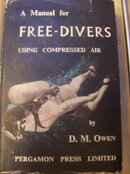James, again (with fear of being repetitive and demanding..and maybe sounding a bit like Halemano)...,why do you feel this?
Genuinely interested to know...
Well, there's a laundry list. But for the high points:
Snag resistance
The smooth butt ends of an inverted tank(s) have been far less likely to hook and retain lines and objects. We train by crawling around in zero vis, with cables and lines hung specifically to dangle and snag us. Most of the time they don't (snag, that is), and when they do, it's trivial to clear. Usually, I don't even need to put a hand behind my neck to clear the line. This is in an environment that I would frankly not even consider taking a standard scuba cylinder into because of the snag hazard.
Valve manipulation
Reaching down to the small of the back is far easier than the conventional valve drill over the shoulder. It is so natural of a motion, just like reaching into a hip pocket. Resistance of the exposure suit usually inhibits over-the-shoulder, and at the waist, it has no effect. I can apply more leverage at the waist, too. And finally, a common issue with conventional valve drills is the tendency to lose trim as folks tuck their heads down, this doesn't happen with inverted valves.
Valve protection
Just look at a conventional set of doubles, with the valves stuck out like the horns on a long-horn steer. They're just begging to be bent or rolled off or something. Inverted valves are so protected I don't think I could roll them off if I tried.
Hoses
This has always been a red herring. My long hose is 7' long, what's the big deal if it's an extra 18"? The same for my necklace. Just cook up a similar routing that's simple. (Remember how askance the recreational diver looks at us with a long hose!)
Failures
If I can figure out that I have a "leak" (airgun simulation in training) from the argon bottle while wearing a 12mm Otter Bay hood, I'm sure I can figure out that I have a leak from a 1st stage while wearing inverted cylinders. And the valve manipulation will be quicker, more sure, and thus lose less gas.
What most folks don't realize about firefighting (SCBA) bottles is the valve on the tank is different from a scuba valve. The SCBA valve is designed to take the weight of the bottle without damaging the regulator. Actually, it's designed to be dropped short distances onto the valve. Without ever seeing this valve, of
course scuba divers can't even imagine inverted cylinders.
Anyway, that's just a cursory look at why I think "inverted valves" have "upright valves" beat. It's just my opinion though, and I really don't want to get into a point-by-point rebuttal over it.
Most folks that are dead set against inverted cylinders, it's been my experience, have never worn a set. For the love of god, try it before forming an opinion! ...I took some of my technical dive buddies, and had them wear my work SCBA, and asked them to turn on the valve. The look of astonishment was priceless.
Does this mean we'll ever see inverted cylinders? I believe no. The industry has entirely too much inertia with upright cylinders, as well as investment in training, equipment, and legacy equipment. That's okay by me, as long as my dive buddy and I are similarly equipped.
All the best, James

